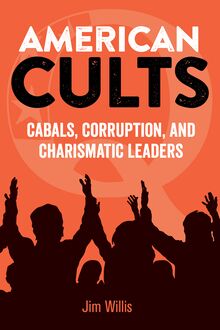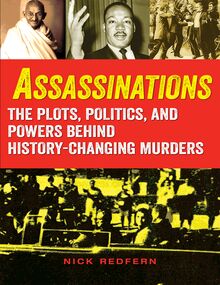Serial Killers , livre ebook
302
pages
English
Ebooks
2021
Vous pourrez modifier la taille du texte de cet ouvrage
Obtenez un accès à la bibliothèque pour le consulter en ligne En savoir plus
Découvre YouScribe en t'inscrivant gratuitement
Découvre YouScribe en t'inscrivant gratuitement
302
pages
English
Ebook
2021
Vous pourrez modifier la taille du texte de cet ouvrage
Obtenez un accès à la bibliothèque pour le consulter en ligne En savoir plus
Publié par
Date de parution
01 avril 2021
Nombre de lectures
0
EAN13
9781578597444
Langue
English
Poids de l'ouvrage
15 Mo
They prey on the innocent with a malicious desire to inflict damage and harm. They hunt and stalk misfortunate victims in the dark, in broad daylight, in quiet neighborhoods, and in the local woods. Their bloodthirst isn't satisfied after their first kill. Or their second. Or third. Serial Killers: The Minds, Methods, and Mayhem of History's Most Notorious Murderers delves into the global phenomenon of serial and spree murderers.
This chilling book looks at the horrifying stories of forty malevolent killers and hundreds of innocent victims, including such notorious homicidal maniacs as John Wayne Gacy, Ted Bundy, and Jeffery Dahmer, but it also looks at lesser-known and overlooked murderers like Herbert Baumeister, America’s I-70 Strangler; Japan’s “Anime Killer,” Tsutomu Miyazaki; Russia’s “Rostov Ripper,” Andrei Chikatilo; the “Giggling Granny,” Nannie Doss; and many more. It journeys to 16th-century Scotland to meet a clan of cannibals whose existence is still debated by historians today, and to the fog-shrouded alleys of Whitechapel, London, where Jack the Ripper earned his grisly namesake. Along the way, we’ll meet the Dating Game Killer, the Milwaukee Cannibal, the Acid Bath Murderer, and other monsters.
Serial Killers also asks the questions …
Caution is advised before entering the alarming world of twisted psychos and sociopaths! With more than 120 photos and graphics, this fright-filled tome is richly illustrated. Its helpful bibliography and extensive index add to its usefulness.
THE NIGHT STALKER—RICHARD RAMIREZ
“Do you admit to being evil, Richard?” Reporter Mike Watkiss asks a simple question. His interviewee, a straggly haired man with dark, piercing eyes who is clad in a prison inmate’s boiler suit, smiles wolfishly for the camera.
“We are all evil, in one way or another, are we not?” The man has a point. He should know, after all, for he is none other than Richard Ramirez—serial murderer, rapist, and self-professed son of Satan. He is more commonly known as The Night Stalker. “Yes, I am evil. Not a hundred percent, but I am evil....”
The interview is taking place in the confines of a cell on California’s death row. Ramirez insists that much of what has been said about him in the media is not true, yet when the veteran journalist gives him the opportunity to clarify things, he blows it off.
“Who are you?” Watkiss asks bluntly.
Ramirez is silent for a while, either pondering the question or at least pretending to, before finally exhaling in a way that suggests it is much too complex for a simple answer.
“Just a guy.”
Yet for somebody who was such a loose cannon in the courtroom (Ramirez was famous for displays of contempt, disrupting the flow of events however he could contrive to) he suddenly becomes coy, bordering on the clinically detached, when asked whether he truly is guilty of thirteen murders.
“It would be improper for me to comment on my LA convictions, and my pending case here in San Francisco,” he replies with great care and deliberation, “because of my appeal.”
However, Ramirez being Ramirez, he cannot help rising to the bait when Watkiss compares him to Charles Manson.
“Serial killers do on a small scale what governments do on a large one,” Ramirez points out. “They are a product of the times, and these are bloodthirsty times. Even psychopaths have emotions if you dig deep enough, but then again, maybe they don’t....”
Watkiss sees an opportunity and takes it. “Do you have emotions, Richard?”
A smirk. I know something you don’t know, it seems to say. “No comment.”
There’s the definite sense that a game is being played, and that Ramirez is enjoying it a great deal more than his opponent, who seems to be having a hard time concealing his disgust at being in Ramirez’s company.
“Killing is killing, whether done for duty, profit, or fun,” Ramirez adds. “Men murder themselves into this democracy.”
This idea that a criminal such as himself is no different than a national government furthering its ends with violent means is a staple argument for Ramirez, something to be conveniently trotted out during an interview in the hope that it won’t be considered too carefully. I’m no different than the good old U.S. of A, the serial killer is basically saying, and while even the most casual study of history demonstrates that governments have indeed been responsible for murder and torture, they do not delight in carrying out such horrific acts in the way that Richard Ramirez plainly did.
Much was made of Ramirez’s supposed connection to Satanism, both during the murder spree itself, when occult symbols were found daubed on the walls at some of his crime scenes, and also during the trial, when Ramirez flashed a palm with a pentagram symbol on it toward the TV cameras. Trying out a new avenue of questioning, Mike Watkiss asks him whether he is a Satanist. Ramirez admits to having studied Satanism but refuses to comment on whether he is a “worshipper of the Devil.”
Satanism, in Ramirez’s words, is “undefiled wisdom instead of hypocritical self-deceit” and “power without charity.” He notes that there has always been evil, which would never come to pass in a perfect world, and he predicts that “it is going to get worse.” Few of us who keep up with current events in the twenty-first century, some thirty years after the serial killer first made this observation, would disagree with him on that score.
Ramirez’s crimes were utterly heinous, yet he developed quite the following of admirers (most of them female) during his incarceration. In a particularly surreal twist, the phalanx of Ramirez groupies included a woman who had been part of the jury that sent him to death row for the crime of murder. He would ultimately go on to get married while awaiting execution and never lacked for letters from his female fans, many of which contained heavy sexual overtones. With long, dark hair framing a Saturnine face, Richard Ramirez could no doubt present a certain attractive appeal to many women ... until, that is, one looked into his eyes.
Of Mexican descent, Ramirez was born on February 29, 1960, in the city of El Paso, Texas. His parents were both immigrants and had four other children prior to him. As a boy, he was diagnosed with epilepsy, and although his seizures gradually diminished in frequency and intensity before finally stopping, author Philip Carlo observes that such a condition can be linked to hyper-aggressiveness in later life.
Carlo also related an account of Ramirez’s cousin, Miguel (known as Mike), who had served in Vietnam as a member of the U.S. Special Forces. The 12-year-old Richard had listened, spellbound, to the older man’s tales of intense firefights against the Viet Cong, and his forcible “conquests” of Vietnamese women afterward. Cousin Mike had saved the best for last, however: he kept a box full of photographs, some of which showed those women performing oral sex on him. The gun Mike held to their heads kept the women both motivated and scared, a lesson in power that the young Richard never forgot. Nor did he forget the image of his cousin holding one of those same women’s decapitated heads in his hand while posing for the camera.
Special Forces soldiers are particularly adept at moving stealthily, using the shadows and darkness as a natural form of cover. These are skills that Richard’s cousin was able to teach him. He found the boy to be a surprisingly quick and enthusiastic learner.
About the Author
Acknowledgments
Preface
Introduction
1. The Cromwell Street House of Horrors—Fred and Rosemary West
2. Clowns Can Get Away with Murder—John Wayne Gacy
3. The I-70 Strangler—Herbert Baumeister
4. The Moors Murderers—Ian Brady & Myra Hindley
5. The Charming Psychopath—Theodore “Ted” Bundy
6. The Lonely Murderer—Dennis Nilsen
7. The Night Stalker—Richard Ramirez
8. Doctor Death—Harold Shipman
9. The Unrepentant Maniac—Carl Panzram
10. Hollywood Monster—Aileen Wuornos
11. Mindhunted—Edmund Kemper
12. The Yorkshire Ripper—Peter Sutcliffe
13. The Anime Killer—Tsutomu Miyazaki
14. The Milwaukee Cannibal—Jeffrey Dahmer
15. Killer at Large—The Zodiac
16. The Dating Game Killer—Rodney Alcala
17. The Giggling Granny—Nannie Doss
18. The Rostov Ripper—Andrei Chikatilo
19. Keeping It in the Family—The Sawney Bean Cannibal Clan
20. The Resurrection Men—Burke and Hare
21. The Grim Sleeper—Lonnie Franklin
22. King of the Murder Castle—H. H. Holmes
23. Busted by the Internet—Maury Travis
24. Say Your Prayers—Anthony Sowell
25. Bind, Torture, Kill—Dennis Rader
26. The Tip of the Iceberg—Samuel Little
27. The Boston Strangler...?—Albert Desalvo
28. The Acid Bath Murderer—John George Haigh
29. The Killer at 10 Rillington Place—John Christie
30. Saucy Jack the Ripper
31. The Houston Mass Murders—Dean Corll
32. Rampage and Spree Killers
33. The Texas Tower Sniper—Charles Whitman
34. The Century 16 Mass Shooting—James Holmes
Further Reading
Index
Publié par
Date de parution
01 avril 2021
Nombre de lectures
0
EAN13
9781578597444
Langue
English
Poids de l'ouvrage
15 Mo
C ONTENTS
Photo Sources
Acknowledgments
Introduction
The Cromwell Street House of Horrors: Fred and Rosemary West
Clowns Can Get Away with Murder: John Wayne Gacy
The I-70 Strangler: Herbert Baumeister
The Moors Murderers: Ian Brady and Myra Hindley
The Charming Psychopath: Theodore Ted Bundy
The Lonely Murderer: Dennis Nilsen
The Night Stalker: Richard Ramirez
Doctor Death: Harold Shipman
The Unrepentant Maniac: Carl Panzram
Hollywood Monster: Aileen Wuornos
Mindhunted: Edmund Kemper
The Yorkshire Ripper: Peter Sutcliffe
The Anime Killer: Tsutomu Miyazaki
The Milwaukee Cannibal: Jeffrey Dahmer
Killer at Large: The Zodiac
The Dating Game Killer: Rodney Alcala
The Giggling Granny: Nannie Doss
The Rostov Ripper: Andrei Chikatilo
Keeping It in the Family: The Sawney Bean Cannibal Clan
The Resurrection Men: Burke and Hare
The Grim Sleeper: Lonnie Franklin
King of the Murder Castle: H. H. Holmes
Busted by the Internet: Maury Travis
Say Your Prayers: Anthony Sowell
Bind, Torture, Kill: Dennis Rader
The Tip of the Iceberg: Samuel Little
The Boston Strangler: Albert Desalvo
The Acid Bath Murderer: John George Haigh
The Killer at 10 Rillington Place: John Christie
Jack the Ripper
The Houston Mass Murders: Dean Corll
Rampage and Spree Killers
The Texas Tower Sniper: Charles Whitman
The Century 16 Mass Shooting: James Holmes
Further Reading
Index
P HOTO S OURCES
ABC Television: p. 196 .
Algr (Wikicommons): p. 357 .
Americasroof (Wikicommons): p. 110 .
Associated Press: pp. 7 , 155 , 166 , 204 .
John Atherton: p. 277 .
Jonathan Billinger / Great Moorcourt Farm / CC BY-SA 2 .0: p. 2 .
California Department of Corrections and Rehabilitation: p. 143 .
City of London [England] Police archives: p. 311 .
Cuyahoga County Sheriff s Office: p. 254 .
Daily Telegraph (London, England): p. 40 .
Des Plaines Police Department: p. 19 .
El Dorado Police Department: p. 260 .
Elkman (Wikicommons): p. 105 .
Gregg M. Erickson: p. 53 .
Richard Estep: pp. 24 , 26 , 29 , 31 .
ExecutedToday.com: p. 236 .
Executive Office of the President of the United States: pp. 16 , 353 .
Federal Bureau of Investigation: pp. 68 , 272 , 276 .
Florida Department of Corrections: p. 119 .
Florida Memory Project, State Archive of Florida: pp. 63 , 65 .
Dual Freq: p. 181 .
Full Sutton Prison: p. 79 .
Geograph Britain and Ireland: pp. 45 , 47 .
Greyloch (Wikicommons): p. 58 .
Indianapolis Police Department: p. 28 .
JetPhotos.com: p. 325 .
Library of Congress: p. 241 .
Los Angeles Police Department: pp. 85 , 229 .
Milwaukee Police Department: p. 180 .
Larry D. Moore: p. 329 .
Mtaylor848 (Wikicommons): p. 150 .
Nonexyst (Wikicommons): pp. 212 , 214 .
The Orchid Club: p. 17 .
Puck magazine: p. 306 .
Rept0n1x (Wikicommons): p. 95 .
Revere Senior High School, Richfield, Ohio: p. 170 .
Rostov (Russia) Police Department: p. 216 .
RustyClark (hottnfunkyradio.com): p. 126 .
Salt Lake County Sherrif s Department: p. 61 .
San Francisco Chronicle : p. 192 .
San Francisco Police Department: p. 191 .
San Quentin State Prison: pp. 92 , 201 .
Santa Cruz County Sheriff s Office: p. 137 .
David Shankbone: p. 84 .
Shutterstock: pp. 5 , 9 , 18 , 37 , 74 , 83 , 88 , 90 , 99 , 100 , 107 , 112 , 121 , 124 , 129 , 132 , 139 , 147 , 149 , 153 , 163 , 164 , 172 , 176 , 188 , 230 , 262 , 266 , 279 , 282 , 289 , 292 , 303 , 316 , 319 , 340 , 344 , 347 , 349 , 356 .
Ian Smith: p. 11 .
Howard Sounes: p. 4 .
Spacemountainmike (Wikicommons): p. 327 .
St. Louis County Jail: p. 247 .
Tulsa Police Department: p. 207 .
United Kingdom government: p. 294 .
University of Texas: p. 336 .
U.S. Army: p. 314 .
U.S. Department of Justice: p. 111 .
Vidor (Wikicommons): p. 57 .
Wakefield Prison: p. 94 .
Chris Whippet / Cranley Gardens, Muswell Hill / CC BY-SA 2 .0: p. 77 .
Wise County Police Department: p. 270 .
Public domain: pp. 20 , 34 , 35 , 42 , 52 , 187 , 190 , 220 , 224 , 225 , 234 , 238 , 240 , 300 , 307 , 308 , 310 , 323 .
ACKNOWLEDGMENTS
I t takes many people to make a book this size a success, and I would like to take this opportunity to extend my sincere gratitude and appreciation to the following:
First and foremost, I d like to thank Roger J necke for giving me the opportunity to undertake this project in the first place. Roger, you were a pleasure to work with, and I am very appreciative of the support and latitude that you afforded me throughout the entire process.
Editing is an underappreciated but crucial part of the publishing process, and thanks are due to Kevin Hile for the time and effort he spent making this a better book.
I d also like to thank my wife, Laura, for not only reading (and correcting) the manuscript from start to finish but offering thoughts and suggestions along the way.
Thanks also go out to my test readers for taking the time to read the manuscript in its early stages and letting me know what worked and didn t work for them. Thank you, Cami Andersen, GinnyRyan Andersen, Linda Fellon, and Jennifer Hirzel.
Last but by no means least, my heartfelt thanks to you, the reader, for spending your hard-earned money on my writing. I appreciate each and every one of you.
INTRODUCTION
F ew things in life seem to fascinate us as much as the phenomenon of the serial killer. One only has to look at the proliferation of movies, television shows, podcasts, and books on the subject to see that. Although the serial killer has always been with us in one form or another, the explosion of interest in serial killer pop culture is relatively new.
Although media coverage of killers such as Ted Bundy and John Wayne Gacy garnered a lot of attention, many attribute the real genesis of this fascination to the release of the 1991 movie The Silence of the Lambs , starring Sir Anthony Hopkins as the quintessential Hollywood serial killer Dr. Hannibal The Cannibal Lecter. Hopkins genuinely creepy and utterly compelling performance in the role catapulted the fictional serial killer into the mainstream, and almost 30 years later that interest shows no sign of waning; if anything, there is a bigger appetite for knowledge and understanding of serial killers than ever before.
Why is this? I think that the root of our fascination lies in the fact that when it comes to the serial killer, we truly are dealing with a monster-evil in its purest and rawest form. Yet, with the exception of a small handful, such as the gleeful Charles Manson, most of them look no different than the rest of us. Indeed, they could easily pass for one of us. They don t have horns or a forked tail. Serial killers look like doctors, waiters, teachers, and construction workers-even game show contestants. Indeed, serial killers have held all these positions and many more besides. They are found in all walks of life and at all levels of society.
They are also not easy to identify. They could be the person sitting in the seat next to you on a flight, or one of the diners at the table behind you in a restaurant, or the person bringing you your food. For all you know, the mechanic working on your car or the nurse giving you a healthcare checkup could be hiding a dark secret, and you would never suspect them until it was too late.
If this sounds like a case of scaremongering on my part then perhaps a little reassurance is in order. Yes, serial killers live and walk among us, often hiding in plain sight, but they are relatively few and far between. Serial killers generally tend to target those who are relative strangers, although there are some exceptions. We are ten times more likely to be killed by a family member or a friend, statistics show, than by a predatory stranger. This is one of the reasons why, when somebody disappears without a trace, suspicion usually first falls upon their significant other or a parent when police start an investigation.
Each serial murderer is different, but many share commonalities. In the same way that a doctor can diagnose the nature of a specific disease or ailment by understanding which physical signs and symptoms make it distinct and unique, so too can we gain a better understanding of the serial killer by comparing and contrasting them, looking at the common features that they share and also those that set them apart.
My main reason for writing this book was to attempt to understand serial killers better, to try and figure out just what it is that makes them do the awful things that they do. Are they simply bad people who are evil and irredeemable? It would be easy to jump to that conclusion and to not explore the issue any further. After all, we are talking about people who rape, torture, and murder whenever they feel the urge-is it even fair to call them people at all? What kind of person could do such monstrous acts? And yet, things are a little more complex than that. The guards at Auschwitz, for example, were ordinary men, many of them married with children. Most had never harmed anyone or anything in their lives before, yet somehow they ended up being willing participants in the extermination of millions of innocent human beings.
I spent many hours poring over newspaper articles, legal documents, books, and video footage to write Serial Killers . Wherever possible, I looked at images of the criminals I was researching at various different stages of their lives. Browsing through the childhood pictures, I was struck by just how unremarkable they had all looked when they were kids. No evil glares or stares, no resemblance to the character of Damien from the movie The Omen. They were just kids. But, at some point in their lives, something changed. Had it taken root in their childhood and grown along with them, or had there been some kind of precipitating event, some sort of physical or emotional trauma, that had sent their lives along a different path-sending them down a road to murder?
You will not be surprised to learn that there were no easy or sim











